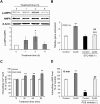Upregulation of skeletal muscle PGC-1α through the elevation of cyclic AMP levels by Cyanidin-3-glucoside enhances exercise performance
- PMID: 28317895
- PMCID: PMC5357948
- DOI: 10.1038/srep44799
Upregulation of skeletal muscle PGC-1α through the elevation of cyclic AMP levels by Cyanidin-3-glucoside enhances exercise performance
Abstract
Regular exercise and physical training enhance physiological capacity and improve metabolic diseases. Skeletal muscles require peroxisome proliferator-activated receptor-gamma coactivator-1α (PGC-1α) in the process of their adaptation to exercise owing to PGC-1α's ability to regulate mitochondrial biogenesis, angiogenesis, and oxidative metabolism. Cyanidin-3-glucoside (Cy3G) is a natural polyphenol and a nutraceutical factor, which has several beneficial effects on human health. Here, the effect of Cy3G on exercise performance and the underlying mechanisms involved were investigated. ICR mice were given Cy3G (1 mg/kg, orally) everyday and made to perform weight-loaded swimming exercise for 15 days. The endurance of mice orally administered with Cy3G was improved, enabling them to swim longer (time) and while the levels of exercise-induced lactate and fatigue markers (urea nitrogen, creatinine and total ketone bodies) were reduced. Additionally, the expression of lactate metabolism-related genes (lactate dehydrogenase B and monocarboxylate transporter 1) in gastrocnemius and biceps femoris muscles was increased in response to Cy3G-induced PGC-1α upregulation. In vitro, using C2C12 myotubes, Cy3G-induced elevation of intracellular cyclic AMP levels increased PGC-1α expression via the Ca2+/calmodulin-dependent protein kinase kinase pathway. This study demonstrates that Cy3G enhances exercise performance by activating lactate metabolism through skeletal muscle PGC-1α upregulation.
Conflict of interest statement
The authors declare no competing financial interests.
Figures






Similar articles
-
Exercise Training-Induced PPARβ Increases PGC-1α Protein Stability and Improves Insulin-Induced Glucose Uptake in Rodent Muscles.Nutrients. 2020 Feb 28;12(3):652. doi: 10.3390/nu12030652. Nutrients. 2020. PMID: 32121211 Free PMC article.
-
Standardized Kaempferia parviflora Extract Enhances Exercise Performance Through Activation of Mitochondrial Biogenesis.J Med Food. 2018 Jan;21(1):30-38. doi: 10.1089/jmf.2017.3989. Epub 2017 Nov 10. J Med Food. 2018. PMID: 29125913
-
Skeletal muscle-specific expression of PGC-1α-b, an exercise-responsive isoform, increases exercise capacity and peak oxygen uptake.PLoS One. 2011;6(12):e28290. doi: 10.1371/journal.pone.0028290. Epub 2011 Dec 8. PLoS One. 2011. PMID: 22174785 Free PMC article.
-
Adaptation of Skeletal Muscles to Contractile Activity of Varying Duration and Intensity: The Role of PGC-1α.Biochemistry (Mosc). 2018 Jun;83(6):613-628. doi: 10.1134/S0006297918060019. Biochemistry (Mosc). 2018. PMID: 30195320 Review.
-
Coordination of mitochondrial biogenesis by PGC-1α in human skeletal muscle: A re-evaluation.Metabolism. 2018 Feb;79:42-51. doi: 10.1016/j.metabol.2017.11.001. Epub 2017 Nov 8. Metabolism. 2018. PMID: 29126696 Review.
Cited by
-
Elucidation of the Molecular Mechanism Underlying Lippia citriodora(Lim.)-Induced Relaxation and Anti-Depression.Int J Mol Sci. 2019 Jul 20;20(14):3556. doi: 10.3390/ijms20143556. Int J Mol Sci. 2019. PMID: 31330819 Free PMC article.
-
Polyphenol supplementation boosts aerobic endurance in athletes: systematic review.Front Physiol. 2024 Apr 8;15:1369174. doi: 10.3389/fphys.2024.1369174. eCollection 2024. Front Physiol. 2024. PMID: 38651044 Free PMC article.
-
Acetic acid stimulates G-protein-coupled receptor GPR43 and induces intracellular calcium influx in L6 myotube cells.PLoS One. 2020 Sep 30;15(9):e0239428. doi: 10.1371/journal.pone.0239428. eCollection 2020. PLoS One. 2020. PMID: 32997697 Free PMC article.
-
Signaling pathways regulated by natural active ingredients in the fight against exercise fatigue-a review.Front Pharmacol. 2023 Dec 14;14:1269878. doi: 10.3389/fphar.2023.1269878. eCollection 2023. Front Pharmacol. 2023. PMID: 38155906 Free PMC article. Review.
-
Anthocyanin-Rich Supplementation: Emerging Evidence of Strong Potential for Sport and Exercise Nutrition.Front Nutr. 2022 Mar 31;9:864323. doi: 10.3389/fnut.2022.864323. eCollection 2022. Front Nutr. 2022. PMID: 35433792 Free PMC article.
References
-
- Egan B. & Zierath J. R. Exercise metabolism and the molecular regulation of skeletal muscle adaptation. Cell Metab. 17, 162–184 (2013). - PubMed
-
- Brønnum-Hansen H., Juel K., Davidsen M. & Sørensen J. Impact of selected risk factors on quality-adjusted life expectancy in Denmark. Scand. J Public Health 35, 510–515 (2007). - PubMed
-
- Liang H. & Ward W. F. PGC-1alpha: a key regulator of energy metabolism. Adv Physiol Educ. 30, 145–151 (2006). - PubMed
Publication types
MeSH terms
Substances
LinkOut - more resources
Full Text Sources
Other Literature Sources
Miscellaneous

